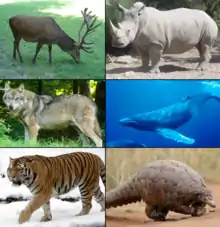Ferungulata
Ferungulata or Fereuungulata is a clade of placental mammals that groups together various carnivorans and ungulates. It has existed in two guises, a traditional one based on morphological analysis and a revised one taking into account more recent molecular analyses.
| Ferungulates | |
|---|---|
 | |
| Scientific classification | |
| Kingdom: | Animalia |
| Phylum: | Chordata |
| Class: | Mammalia |
| Clade: | Scrotifera |
| Clade: | Ferungulata Simpson, 1945 |
| Subgroups | |
| |
| Synonyms | |
| |
The traditional Ferungulata was established by George Gaylord Simpson in 1945.[2] It grouped together the extant orders Carnivora, Perissodactyla and Artiodactyla with the Tubulidentata and the superorder Paenungulata, as well as a number of orders known only from fossils. Although Simpson placed whales (Cetacea) in a separate cohort, recent evidence linking them to Artiodactyla would mean that they belong here as well.
Simpson established the grouping on the basis of morphological criteria, but this traditional understanding of Ferungulata has been challenged by a more recent classification, relying upon genetic criteria.[3][4] These studies separated his ungulate orders into two distinct placental groups, within Afrotheria and Laurasiatheria, respectively. The 'true' ungulates, Perissodactyla and Artiodactyla, along with the whales, are included in the revised group, along with the Carnivora, and with the addition of pangolins (Pholidota), but the Tubulidentata and paenungulates are excluded. To reflect this difference, the revised clade is usually referred to as Fereuungulata. The Fereuungulata is a sister group to the Chiroptera (bats) and together they make up Scrotifera.
| Phylogenetic position of the Ferungulata in the context of the order-level cladogram of Boreoeutheria (only living groups). | |||||||||||||||||||||||||||||||||||||||
| |||||||||||||||||||||||||||||||||||||||
| The cladogram has been reconstructed from mitochondrial and nuclear DNA and protein characters. |
| Phylogeny within clade Ferungulata[5][6][7][8] | |||||||||||||||||||||||||||
|
See also
References
- Xuming Zhou, Shixia Xu, Junxiao Xu, Bingyao Chen, Kaiya Zhou, and Guang Yang (2012) Phylogenomic Analysis Resolves the Interordinal Relationships and Rapid Diversification of the Laurasiatherian Mammals
- Simpson, George Gaylord (1945). "The principles of classification and a classification of mammals". Bulletin of the American Museum of Natural History. 85: 350. hdl:2246/1104.
- Waddell; et al. (1999). "Using Novel Phylogenetic Methods to Evaluate Mammalian mtDNA, Including Amino Acid-Invariant Sites-LogDet plus Site Stripping, to Detect Internal Conflicts in the Data, with Special Reference to the Positions of Hedgehog, Armadillo, and Elephant" (PDF). Systematic Biology. 48 (1): 31–53. doi:10.1080/106351599260427. PMID 12078643. Retrieved 4 October 2011.
- Zhou, X.; Xu, S.; Xu, J.; Chen, B.; Zhou, K.; Yang, G. (2011). "Phylogenomic Analysis Resolves the Interordinal Relationships and Rapid Diversification of the Laurasiatherian Mammals" (PDF). Systematic Biology. 61 (1): 150–164. doi:10.1093/sysbio/syr089. ISSN 1063-5157. PMC 3243735. PMID 21900649.
- O’Leary, M. A., Bloch JI, Flynn, J. J., Gaudin, T. J., Giallombardo, A., Giannini, N. P., Goldber, S. L, Kraatz, B. P., Luo, Z-X, Jin Meng, Xijun Ni, Novacek, M. J., Perini, F. A., Randall, Z. S., Rougier, G. W., Sargis, E. J., Silcox, M. T., Simmons, N. B., Spaulding, M. Velazco, P. M., Weksler, M., Wible, J. R. Cirranello, A. L. (2013.) "The Placental Mammal Ancestor and the Post–K-Pg Radiation of Placentals." Science 339:6120:662-667.
- Burger, Benjamin J. (2015-10-15). The Systematic Position of the Saber-Toothed and Horned Giants of the Eocene: The Uintatheres (Order Dinocerata) (PDF). Society of Vertebrate Paleontology 75th Annual Meeting. Dallas. Retrieved 2020-02-20. Conference abstract (p. 99). Explanation and conclusions: Episode 17: Systematic position of the Uintatheres (Order Dinocerata) on YouTube.
- Orliac, M. J.; o'Leary, M. A. (2016). "The inner ear of Protungulatum (Pan-Euungulata, Mammalia)". Journal of Mammalian Evolution. 23 (4): 337–352. doi:10.1007/s10914-016-9327-z. S2CID 33676627.
- Frank Zachos (2020.) "Mammalian Phylogenetics: A Short Overview of Recent Advances"